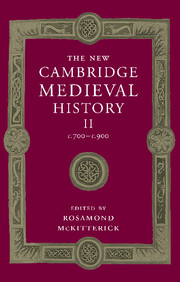Book contents
- Frontmatter
- PART I POLITICAL DEVELOPMENT
- 1 Introduction: sources and interpretation
- 2 The British Isles
- 3 Frankish Gaul to 814
- 4 The Frankish kingdoms, 814–898: the West
- 5 The Frankish Kingdoms, 817–911: the East and Middle Kingdoms
- 6 Fines Imperii: the Marches
- 7 The Vikings in Francia and Anglo-Saxon England to 911
- 8 Scandinavia, c. 700–1066
- 9 Slavs and Bulgars
- 10 The Muslims in Europe
- 11 Spain: the northern kingdoms and the Basques, 711–910
- 12 Lombard and Carolingian Italy
- 13 Byzantine Italy, c. 680–c. 876
- 14 Byzantium and the west, 700–900
- PART II GOVERNMENT AND INSTITUTIONS
- PART III CHURCH AND SOCIETY
- PART IV CULTURE AND INTELLECTUAL DEVELOPMENTS
- Conclusion
- Appendix genealogical tables
- List of primary sources
- Bibliography of secondary works arranged by chapter
- Index of manuscripts
- General index
- Frontispiece">
- Plate section
- Map 4 Charlemagne’s Europe and Byzantium, 814
- Map 19 The ecclesiastical provinces of western Europe 700-900
- Map 20 Carolingian schools, scriptoria and literary centres
- Genealogical table X: Wessex
- References
9 - Slavs and Bulgars
from PART I - POLITICAL DEVELOPMENT
Published online by Cambridge University Press: 28 March 2008
- Frontmatter
- PART I POLITICAL DEVELOPMENT
- 1 Introduction: sources and interpretation
- 2 The British Isles
- 3 Frankish Gaul to 814
- 4 The Frankish kingdoms, 814–898: the West
- 5 The Frankish Kingdoms, 817–911: the East and Middle Kingdoms
- 6 Fines Imperii: the Marches
- 7 The Vikings in Francia and Anglo-Saxon England to 911
- 8 Scandinavia, c. 700–1066
- 9 Slavs and Bulgars
- 10 The Muslims in Europe
- 11 Spain: the northern kingdoms and the Basques, 711–910
- 12 Lombard and Carolingian Italy
- 13 Byzantine Italy, c. 680–c. 876
- 14 Byzantium and the west, 700–900
- PART II GOVERNMENT AND INSTITUTIONS
- PART III CHURCH AND SOCIETY
- PART IV CULTURE AND INTELLECTUAL DEVELOPMENTS
- Conclusion
- Appendix genealogical tables
- List of primary sources
- Bibliography of secondary works arranged by chapter
- Index of manuscripts
- General index
- Frontispiece">
- Plate section
- Map 4 Charlemagne’s Europe and Byzantium, 814
- Map 19 The ecclesiastical provinces of western Europe 700-900
- Map 20 Carolingian schools, scriptoria and literary centres
- Genealogical table X: Wessex
- References
Summary
at the beginning of the eighth century only three political structures of substance impinged upon the Balkans. Two of them belonged to quite recent arrivals from the Eurasian steppes, the Avars and the Bulgars, while the third comprised the remnants of the eastern Roman empire which had, until the sixth century, encompassed the entire peninsula. It must be emphasised that the empire never unreservedly gave up its claim to ultimate authority over the whole area south of the lower or middle Danube, for all the treaties which it had perforce to ratify with the more formidable of the intruders. Equally, the most numerous immigration – of the Slavs – was also, by and large, the least systematically violent, leaving intact many visible symbols of the empire, for example, governors’ residences and churches. The Byzantine government’s periodic assertions of its rights of proprietorship were therefore not wholly lacking in physical corroboration, while the presence of Greek-speaking and, presumably, largely Christian communities was a further reminder of a past order. Not all Greek-speakers, however, necessarily regarded themselves as owing service to the remote and apparently ineffectual emperor on the Bosphorus.
The secession of Greek Christian and other groups from the Avar khanate points to the strains which a federation of steppe nomads and subject peoples was liable to undergo, as the momentum of campaigning and plundering gradually gave way to a sedentary, less martial way of life. This tendency was already pronounced by the late seventh century and continued through the eighth. The majority of the population engaged in agriculture, as the many finds of sickles in burial grounds attest, although some Avars may have maintained a degree of pastoral nomadism.
- Type
- Chapter
- Information
- The New Cambridge Medieval History , pp. 228 - 248Publisher: Cambridge University PressPrint publication year: 1995
References
- 9
- Cited by

